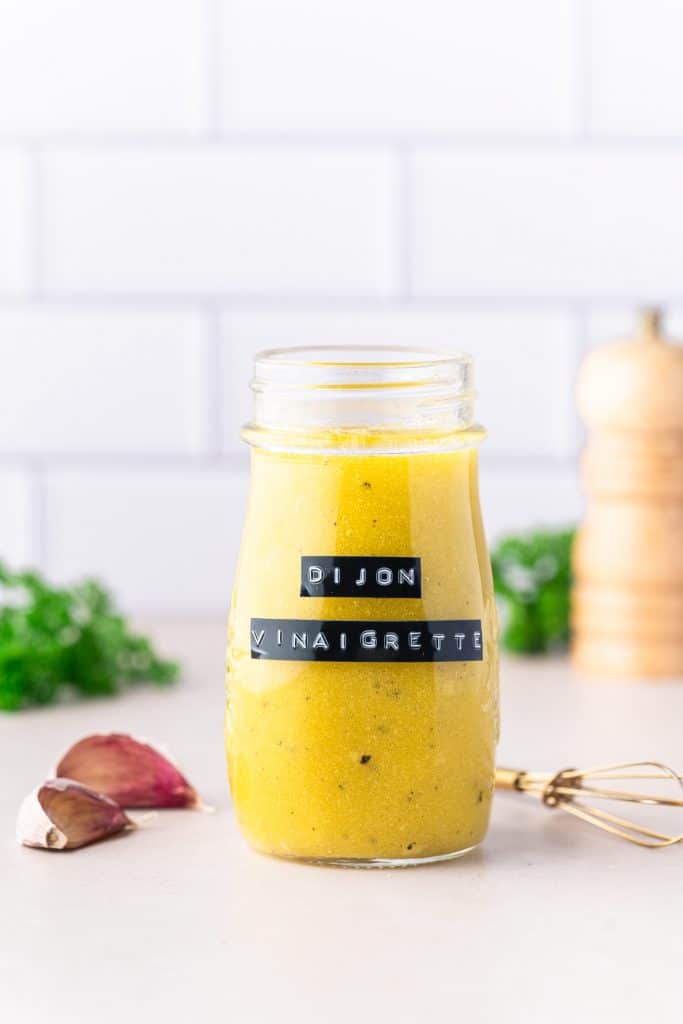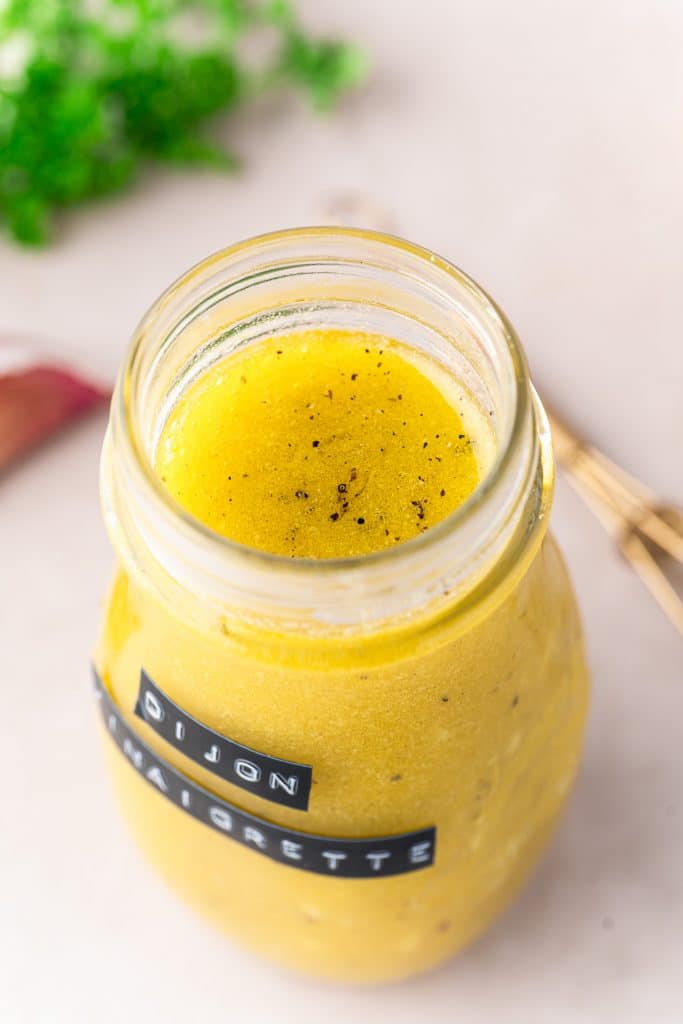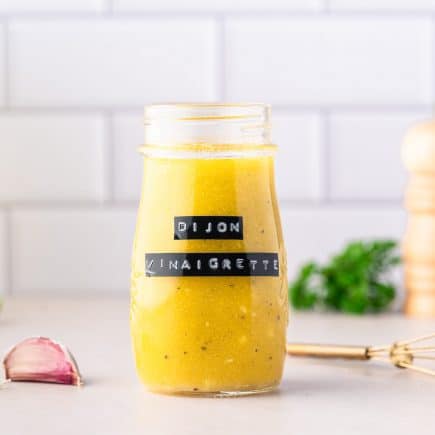Easy Dijon Mustard Vinaigrette

This easy Dijon vinaigrette keeps for a long time, so I always have some on hand in my fridge to serve make a quick green salad as a side dish or other salad recipes or even as a dipping sauce.
Say goodbye to bland salads and hello to the wonderful world of homemade vinaigrettes! You can use it in a wide range of salads, such as tomato and cucumber salad, fresh salmon salad, this winter lentil, tomme cheese and hazelnut salad, or the traditional Nicoise salad.
Table of content
What is a Vinaigrette?
A Vinaigrette is a classic French salad dressing originally made from Dijon mustard, vinegar, and oil.
Dijon mustard is a type of mustard that originated in the city of Dijon in the Burgundy region of France. It is named after the city itself. Dijon mustard is known for smooth texture and its strong and spicy flavor.

List of ingredients
Made with high-quality ingredients and no preservatives, this simple Dijon vinaigrette
- Olive oil: Olive oil is the base for this vinaigrette. It adds richness and smoothness to the dressing. I recommend an olive oil extra virgin for best flavor. You can replace it with any vegetable oil like sunflower, canola oil, walnut oil etc.
- White wine vinegar: White wine vinegar adds an acidic kick with a hint of sweetness.
- Dijon mustard: Dijon mustard adds a robust flavor to the vinaigrette. It is a natural emulsifier and helps the vinegar and oil to combine to gives the vinaigrette a tangy flavor and a creamy texture. You can also use a simple or whole grain mustard.
- Garlic: It’s an optional ingredient. It adds a deep savory flavor to the vinaigrette. You can replace garlic with shallots.
- Salt and black pepper: Salt enhances the flavors and black pepper adds a subtle kick to the dressing.
You will find the exact quantities in the recipe card.

How to make Dijon Mustard Vinaigrette?
The ratio
In my opinion, the suggested ratio of 3:1, meaning 3/4 parts olive oil to 1/4 part vinegar, often found in many recipes, tends to result in a vinaigrette that is excessively oily. For the best flavor, I recommend using a ratio 1:2, 1 part vinegar to 2 parts oil.
The classic method
The classic vinaigrette should usually be prepared with a whisk or a fork.
- Step 1: Add the white wine vinegar and the salt in a small bow, whisk to dilute the salt.
- Step 2: Add the Dijon Mustard and mix.
- Step 3: While whisking continuously, slowly pour the olive oil into the bowl in a steady stream. Keep whisking until the mixture thickens and emulsifies.
- Step 4: Add garlic or shallots (optional) and whisk one last time.
The lazy method
Even if it’s not the classic method, I like to prepare my vinaigrette in a small container such as a mason jar or a small glass bottle with lid. Using a jar reduces the number of utensils needed for making vinaigrette. Instead of using a small bowl and a whisk or fork, you can use the jar for both mixing and storage.
- Step 1: In a small jar or container, add the white wine vinegar, salt, Dijon mustard.
- Step 2: Pour the olive oil at once and close the lid. Shake for a few seconds until the vinaigrette emulsifies.
- Step 4: Add garlic or shallots (optional) and whisk one last time.

Variation ideas
Add the following things to your Dijon Mustard Vinaigrette and make it even more tasteful.
- Honey/Maple Syrup: Add sweetness to your vinaigrette by incorporating honey or maple syrup.
- Lemon: To add a citrus flavor, substitute vinegar for lemon juice.
- Vinegar: You can use red wine or apple cider vinegar instead of white wine vinegar for a different flavor profile. However, note that each type of vinegar will add a unique taste to the vinaigrette.
- Fresh or dried herbs: Add different herbs, such as parsley, chives, thyme or rosemary to give your dressing a unique flavour.
Geraldine’s tips
If you’re preparing Dijon Mustard Vinaigrette for the first time, here are some helpful tips to ensure optimal results:
- For best results, pour the vinaigrette onto your salad just a couple of minutes before serving to make sure the salad leaves remain fresh and crisp.
- Adjust the taste by adding olive oil if the dressing is too acidic, or a little vinegar and mustard if it is too bland.
- I recommend serving the dressing at room temperature for maximum flavor.
- Prepare a generous amount of Dijon mustard vinaigrette and keep it in your fridge to always have an homemade salad dressing to prepare quick salad recipes during busy weeknights.
Frequently Asked Questions
Store Dijon Mustard Vinaigrette in an airtight container in the refrigerator, and it will stay good for up to seven days.
You might find freezing this vinaigrette a tempting idea, but it is not recommended. That’s because the oil and vinegar will separate. As a result, its texture and flavor will change.
Yes, you can make this dressing ahead of time.
Don’t hesitate to leave me a comment, it always makes me happy!

You can also find me on Instagram, Facebook and TikTok to see behind the scenes of my blog
Recipe card
Easy Dijon Mustard Vinaigrette
Click on the stars to rate!

Equipment
- 1 small jar with lid
Ingredients
- 2 tsp Dijon mustard
- 1/2 cup white wine vinegar 125 ml
- 1 cup olive oil 250 ml
- 1 pinch of salt
- Black pepper
- 1 garlic clove
Instructions
- In a small jar or container, add the white wine vinegar, salt, Dijon mustard.
- Pour the olive oil at once and close the lid. Shake for a few seconds until the vinaigrette emulsifies.
- Add garlic or shallots (optional) and whisk one last time.